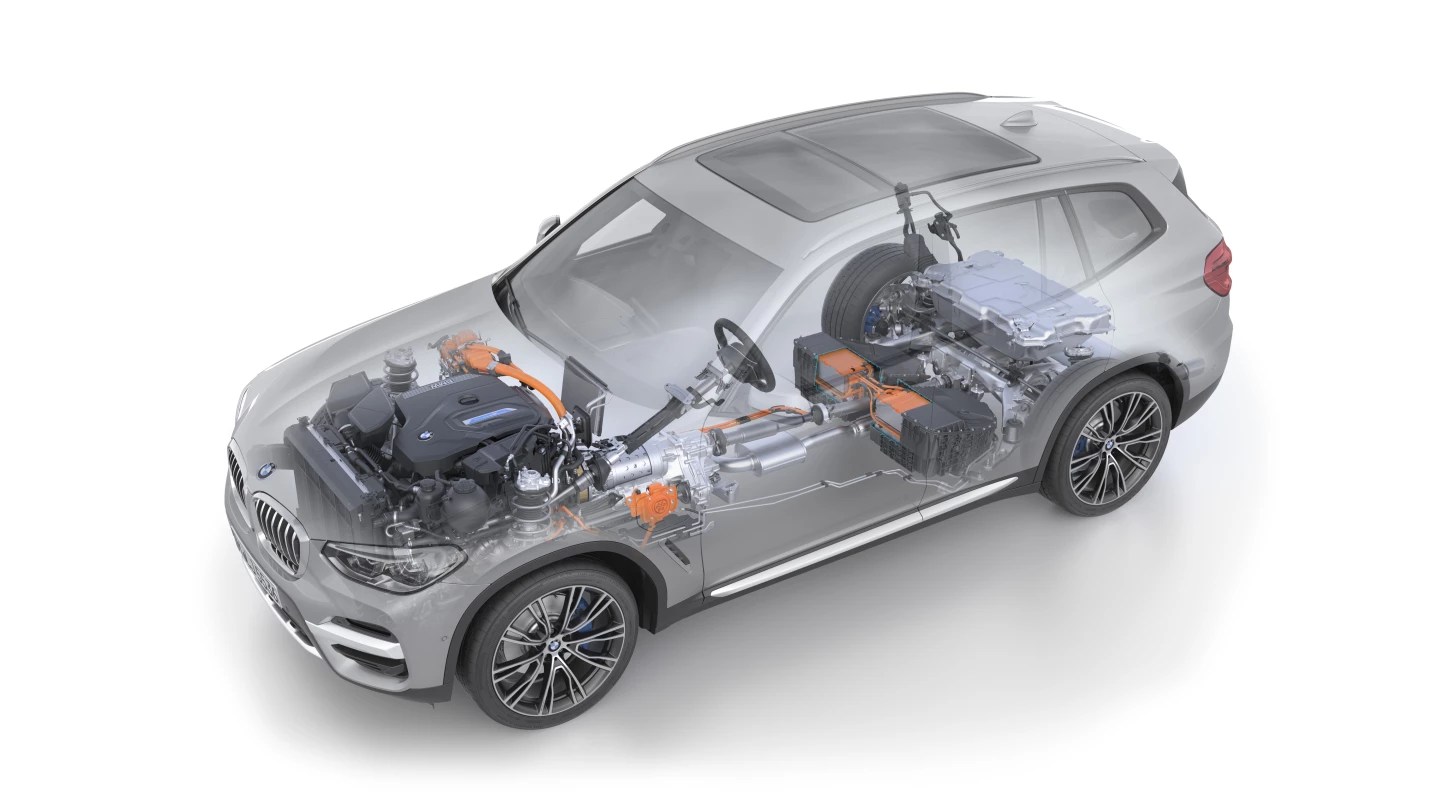BMW has been slowly electrifying all of its vehicles. The small X3 crossover has been a popular staple in the automaker's lineup for a few years, offering family-sized luxury with BMW’s signature driver’s focus. Now the X3 has a plug-in option, the X3 Hybrid.
The vehicle builds on the well-done X3 "sport activity vehicle" (SAV) models, which have spacious interiors, good performance, and eye-catching good looks. The standard X3 (the sDrive30i) is powered by a 2.0-liter four-cylinder engine and eight-speed automatic transmission in front-wheel drive. Its xDrive30i twin is the same, but adds all-wheel drive. Both have 248 peak horsepower (185 kW). Then there’s the M series for the X3, starting with the M40i and going to the M and the M Competition, all of which use a 3.0-liter six-cylinder with an eight-speed automatic. Power outputs range from 382 to 503 horsepower (285-375 kW).
The 2020 BMW X3 Hybrid, also known as the xDrive30e, adds about 40 horsepower to the total output of the standard X3 model (boosting it to 288), which more than makes up for the added weight of the battery and electronics that come with the plug. The added electronics give the X3 Hybrid about 18 miles (29 km) of all-electric driving (EPA estimated), but the xDrive30e then becomes less fuel-efficient under gasoline power than its standard gasoline counterpart. So the efficiency return is a mixed bag.

The comparable BMW X3 xDrive30i, the "base model" all-wheel drive option, is EPA-rated at 27 mpg combined (8.7 l/100km), with 25 mpg in the city and 29 mpg on the highway. The xDrive30e plug-in hybrid has a total combined rating of 60 MPG-equivalent (3.9 l/100km). Assuming a standard daily commute of 15 miles (24 km), most X3 Hybrid owners would be able to do most of their driving without using any gas. Reality, of course, interferes, adding things like cold weather, in-cabin electronics use, and deviations from the regularly scheduled drive pattern ... never mind the "I forgot to plug in" problem.
That’s where fuel economy gets a little sketchier. The EPA says that the hybrid receives 24 mpg (9.8 l/100km) when running on its gas engine. That’s significantly lower than the 27 that the standard gas model uses. Noted during our time with the X3 xDrive30e was that cold weather and highway driving significantly affect the efficiencies listed. With a full charge and a roundtrip freeway run of 22 miles (35 km) at 75 mph (121 km/h), we achieved only 25.3 mpg (9.3 l/100km). We noted that on freeway onramps, the engine started up (even with a full battery) and would run during much of the higher-speed driving. In everyday driving, the engine would run intermittently to power cabin heating (it is winter in Wyoming, after all) and so forth.

Yet for all of that, the plug-in hybrid X3 and its 12-kWh battery are a great option. When driving on the daily and not at freeway speeds, the X3 returned excellent fuel economy results. While more difficult to measure, our returns at high altitude and in-city driving were very good, closing in on that 60 MPGe EPA estimate with a daily plug-in. Charging the X3 requires about 12 hours on a standard 120V household outlet and about 3.5 hours at a level 2 charging station. That’s assuming the battery is empty. Most of our charge times were significantly lower than those, as we rarely used all of the battery’s range in normal daily driving around town.
The 2020 BMW X3 Hybrid has only one trim level, but comes packed with standard features for its US$49,600 price tag. Sporting premium amenities like three-zone climate control, BMW sport seating for the driver and front passenger, a 10.25-inch infotainment display, 12-speaker audio, wireless Apple CarPlay and Android Auto, plus forward collision warning with emergency braking, the X3 Hybrid starts out pretty fine. With nearly all options added, though, our test model rang in at $63,000 and change.
Having driven the X3 before in its gasoline model, our assessment here is that adding the plug will probably be a good thing for most drivers. The roughly $6,000 premium paid to get that plug and battery may not always make sense, but many drivers may see enough of a boost in drive quality and (maybe) efficiency to make up for it.
Product Page: 2020 BMW X3













